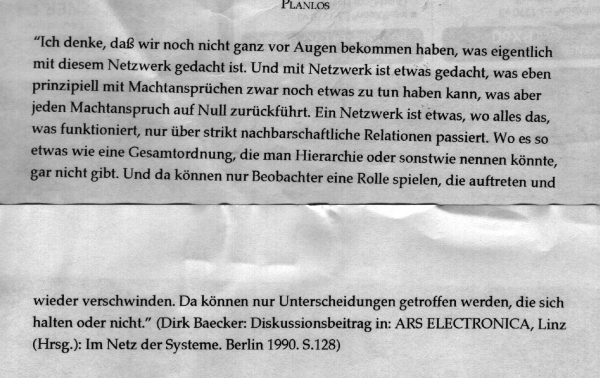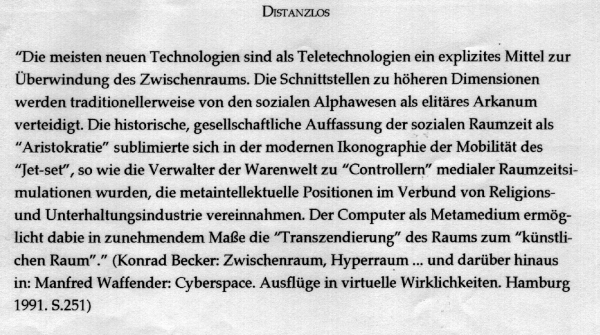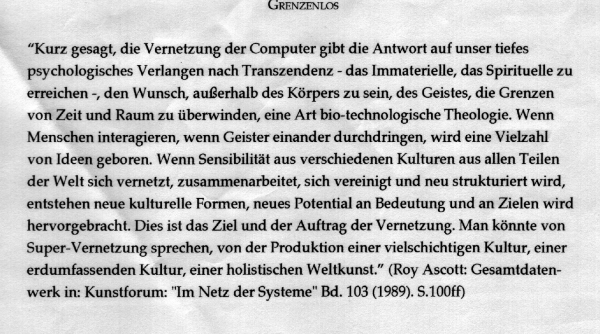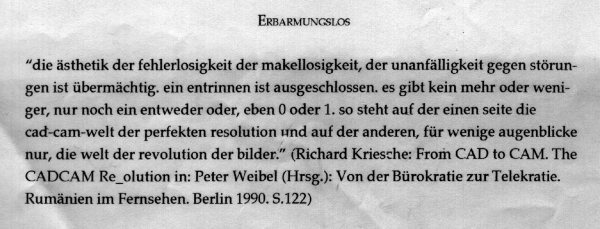Telepräsenz (PhÜD)
Inhaltsverzeichnis
- 1 Phantasien
- 2 Mediated Presence
- 2.1 The hype surrounding tele-presence deserves to be taken seriously.
- 2.2 We cannot afford current, easy explanations of tele-presence.
- 2.3 Our web of belief is under stress. Tele-presence calls for a re-examination of some basic concepts in epistemology.
- 2.4 Presence refers both to a mode of time and to a spatial quality. This link-up is under serious stress and should be used with care.
- 2.5 To cope with mediated presence a new kind of geography will have to be developed.
- 2.6 History is impossible without bodies, which are impossible without distance.
Phantasien
Mediated Presence
The hype surrounding tele-presence deserves to be taken seriously.
Captions like Telepresence: A Technology Transcending Time and Space or Telepresence: live, interactive, look where you want video on the Internet evoke flights of metaphysical phantasy together with more robust reflexes, familiar from e-commerce.
William J. Mitchell has noted with respect to the term cyberspace: "It's a figure of speech that has emerged to cover a gap in our language."
- Telepresence is the art of enabling social proximity despite geographical or temporal distances through the integration of computers, audio-visual, and tele-communicative technologies. [1]
Spatial distance and temporal duration seem indeed to have vanished in the age of global, inter-active telecommunication. It might be objected that networked computers have obviously neither abolished space nor time. True enough, but this objection marks a fallback position without facing the challenge.
We cannot afford current, easy explanations of tele-presence.
One way to see the problem is to observe that we cannot make sense of the puzzlement we are faced with without a working distinction between proximity and distance. Paul Virilio complains that:
- "closer to what is far away than to what is just beside us, we are becoming progressively detached from ourselves."
There is no way to comprehend the complaint but to master the ordinary use of closeness. It has to be presupposed and supplemented with the additional twist suggested by the author. Imagine someone lacking any understanding of closeness: she will not profit by being told that newly available techniques are bringing distant events close to her. We need a concurrent mastery of tele-distance to be able to distinguish between the physical environment and those peculiar impressions we want to classify as close by, yet coming from afar. And we have to keep this separate from the close distance a phenomenologist might want to describe, e.g. the tension arising between persons keeping away from each other in an elevator.
The reason for the confusion often encountered in promotional talk about tele-presence is quite simple. Certain concepts such as left and right or true and false work in pairs, hence the occasional temptation to overstress one component. A notorious example is Baudrillard's universal simulation. Such conceptual extravaganzas almost inevitably lead into dead ends. As soon as it is recognized that deception only makes sense vis a vis knowledge the pendulum swings back: If there is no knowledge, there is no deception either. The dialectics between proximity and distance is a case in point.
Our web of belief is under stress. Tele-presence calls for a re-examination of some basic concepts in epistemology.
Human perception is regarded as an essential ingredient in the acquisition of knowledge. Humans are sentient organisms, interacting with their environment in space and time, according to their capacities of apperception. It is trivially true that sensual input into the nervous system has to be triggered by stimulation arising within the vicinity of the receiving entity. Anti-metaphysical empirical philosophy, in due course, established sensory affection as a prerequisite of the epistemological process.
Causal chains are, however, not restricted to the neighborhood. A person can be affected by nuclear radiation or by the depletion of the earth' ozone shield. The scope of technologically mediated impingement upon the human subject has been spectacularly enlarged in the preceeding century, just think of electricity, wireless communication and computer networks. Our familiar epistemological scenario has been developed to model the cognitive process accompanying the lightening of a candle, but it is seriously overtaxed in dealing with a light switch.
The characteristic ingredient in any epistemological account is the use of signs. Semiotic dimensions are orthogonal to causal dependencies. Perceiving a word or a picture is not just a case of submitting to a physical input. The recognition of an actress in a newspaper, to pick an example, is peculiarly exempt from her physical whereabouts. The workings of human cognition have usually been discussed within certain semiotic frameworks, the most prominent tools of mediation being concepts or sentences. Such bearers of information content seem to occupy a realm very different from electrical currents running though a wire. Still, in a way that's ancient history. One important presumption underlying the classical setup has become obsolete.
Old signs were pretty static: spoken words, texts, pictures. Their presence to the senses was an all or nothing affair. A meaningful utterance has to be heard by someone, sharing the speaker's location. A given text had to be perceived within a narrowly defined environment. There simply was no option of a text being presented via causal mechanisms from the opposite end of the world in real time.
A dramatic change has, however, occured on the level of technological mediation: contemporary machinery allows us to significantly enhance the causal underpinnings of sign systems. It has become impossible to base knowledge claims exclusively on neighbourhood perception. A live report on TV does not fit into the pattern of the testimony of the senses. When a reporter addresses her audience via a screen we assume a causal chain leading far beyond the living room and giving credibility to her sentences. Classical epistemology distinguishes between sensual affections and conceptual activity. It does not provide a place for cognitive content transmitted by instant tele-mediation.
Presence refers both to a mode of time and to a spatial quality. This link-up is under serious stress and should be used with care.
Language provides a nice illustration of the preceeding claims about the tele-epistemological innocence of classical philosophy. It offers the same expression, namely presence, to designate a given moment and attendance at a given moment. To be present easily extends into at the present time. The reason is quite clear. Given the typical scenario of knowledge acquisition prior to the advent of telecommunication sensual perception of spatial objects -- exempting objects seen through a telescope -- coincided with their actual presence. Signs have, of course, always been able to bridge large distances. But they were simply not hooked into an extended causal framework of technologies transmitting information from a given place to distant places with practically no delay.
The outcome is well known: telephone, radio, TV and the Internet offer a kind of semiotic globalization, i.e. they provide regimes of symbols that are no longer governed by the constraints common to ordinary speech, writing and print.
Make no mistake: qua signs the color dots on the monitor are not at all immediate. Their pervasive presence is not a means to overcome the distance between signifier and signified. Still, we can hardly escape the strong impression of something one might call representational immediacy which is a tentative description of a specific techno-semiotic arrangement, namely the instant availability of a set of symbols around the globe at any given time. Just think of the huge TV-screens installed in some soccer stadiums. They depict the game, as seen in million homes, to the crowd attending the actual event. To talk about the disappearance of distance and duration does seem to make sense in such circumstances.
It is, nevertheless, a misguided move as can be shown by the following argument. Spatial categories, it is true, fail us in a certain, significant sense, as the crowd's enthusiasm is fed by pictures manipulated in a remote recording studio. This does not, however, imply the breakdown of duration, quite the contrary. The whole point of the exercise is to let spectators across the continent participate in a given moment. Presence in the temporal sense remains very much in force.
It is impossible to have tele-presence without a common spatial and temporal grid, but both differ in a significant way. The entire planet can be regarded at one moment in time -- it cannot in the same sense be positioned at one single spatial coordinate. All of mankind may for certain purposes be treated as being co-present in a temporal sense, but it cannot be physically joined together in Budapest.
We have to come to terms with a pervasive break of symmetry as the spatial meaning of presence is split off from its temporal meaning. In tele-presence people are sharing a particular moment, but they do not share a common place in a comparable meaning of the term.
To cope with mediated presence a new kind of geography will have to be developed.
In former times typical representations were closely dependent on place and change of place. A painting by Rembrandt has to be moved to an exhibition outside Amsterdam, and -- even discounting the aura -- its photographic similes occupy definite locations. The tense present of telecommunication imposes different rules on verbal pictorial content. Even though a politician's speech might still be delivered to a local audience, there is all the difference between this occasion and its being reported on television.
These are relatively modest implications of tele-presence; challenges we have had half a century to face. But, as a glance at recent technical advances shows, the comparatively familiar informational set-up of the 20th century is in turmoil. Jacking a microphone into my sound-card and assuming a certain set of software tools I can talk to any person on the Internet for very little money for an unlimited amount of time. How should this option be called? It's neither radio, nor telephone in any established sense, just as web-cams are neither films nor TV. The situation is similar to 19th century architecture which superimposed its ancient canon of forms upon the new building materials. Mediated presence is full of surprises and possible embarrassments.
History is impossible without bodies, which are impossible without distance.
The hype surrounding tele-presence deserves to be taken seriously. But how to avoid profound hype? Here are some tentative observations on a high level of abstraction, combining both descriptive content and metaphysical impact.
The nuclear bomb was the first device which made people aware of the fact that a single, local action could have instant global repercussions up to the destruction of the planet. On a more peaceful note the moon landing was a historical moment, demonstrating how, at a certain date, the entire globe could be considered one united location. The quality of temporal presence can thus be projected onto the spatial framework. Nuclear energy and broadcasting are comparatively unsophisticated examples to make this point. Mediated presence has become much denser. In 2001 private mobile phones rather than the military power of the United States provided immediate responses to an ongoing terrorist attack. Such incidences seem to suggest that we will have simultaneity plus ubiquity in the not too distant future, i.e. tele-presence in the strong sense.
This prognosis rests upon a conceptual confusion. Symbol systems are capable of literally presenting states of affairs across big distances and they can, nowadays, be linked to their sources with the speed of light. This makes for causal simultaneity which may even go both ways, including feedback to the originating source. And causally triggered events can, in the limiting case, engulf the entire space-time.
But here is the catch as far as tele-communication is concerned: symbols are different from causes. To put it in more cautious analytic terms: we are dealing with two autonomous levels of description, difficult to reconcile. Global warming is a causal process affecting the entire planet, but it does not carry any particular information.
The fact that engineers have managed to encode content into such natural phenomena should not lead us to confuse causal connections with symbolic features. Even if the symbolic medium is, in a way, omnipresent, this does not mean that we are in the presence of the things symbolized. To use a symbolism amounts to recognize a categorical distinction between the material of the signifier and its designation. This holds for pointing to an adjacent tree as well as for recognizing the face of a singer on TV. The speed of light and feedback mechanisms simply do not enter into this equation.
The conclusion is not that one should be insensitive towards the implications of instant global signification technology. It's just a reminder that symbols differ from simple objects. Human evolution is built upon this mild case of schizophrenia which makes us able to present an object that is physically absent. Tele-presence seems to hold the promise of this gap to be eventually closed. But think again. What would be achieved if signs were to be fused with designations within a single cosmic instant?
Cosmological theory tells us that the history of the universe can only be reconstructed from radiation caught by our observation instruments in earth-time. To arrive at an astronomical understanding such signals have to be mapped back onto space-time, reintroducing distance, absence and process. Now imagine the planet viewed in God-like immediacy from a far away galaxy. All significant spatial relationships would be merged into a tiny spot of light. An intelligent being out there would have to unravel the mystery, re-introducing a pattern of spatial coordinates and symbolic communications bridging its extension to understand the human condition. The thought experiment can have a sobering effect. If you are tempted to regard tele-presence as an overcoming of distance and duration, think of yourself as looked upon from a distant galaxy. You are an unremarkable blob, waiting to be reverse engineered into a story within time and space.



